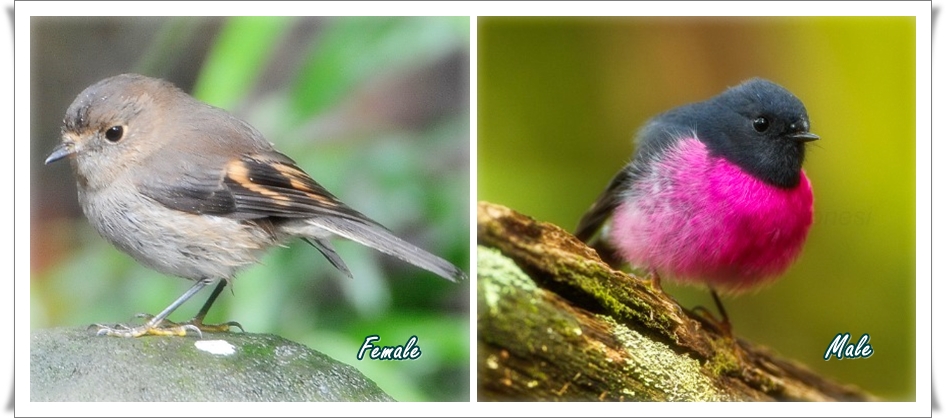The pink robin (Petroica rodinogaster) is a small, brightly colored passerine native to Southeastern Australia. A cool temperate forest in far southeast Australia is its natural habitat. The sexually dimorphic pink Robin belongs to the family Petrocidae. Moreover, pink-breasted Robin is another name for this bird. Approximately 120–130 mm is the length of the pink robin.

The dazzling Pink Robins live in the recesses of temperate rainforest and wet sclerophyll forests, which feature shady undergrowth and fem-filled gullies. Nothofagus and Southern Sassafras atherosperma are often dominant trees. Many pairs remain in the same territory or its environs year-round, but others migrate seasonally, especially the young in winter, who disperse northward through more open areas. Every autumn and spring, birds pass quietly through Canberra, if unobtrusively, en-route to the central New South Wales coast. The evidence showing Tasmanian robins cross the Bass Strait is circumstantial at this point.

Although the Pink Robin is just as solitary and quiet as its close relative, the Rose Robin, it still forages strictly within the forest substage. Pink robin calls are low, sharp, monotonous ticks, like snapping small twigs or clicking grasshoppers, by both sexes; in agitation, the call changes to a short, rasping Twitter. However, the male sings a tinkling chatter of up to seven notes that he repeats repeatedly from his perch, then he whistles up and down.
Feeding is characteristic of its behavior. Individuals or pairs of birds flit silently through the undergrowth from low vantage points, about 50–200 centimeters above the ground. They watch intently from each perch, their bodies hunched and their wings and tail drooping and flicking erratically as they wait for varying amounts of time before moving on.

In flight, pink robins are low, dashing, and erratically undulating. The birds usually catch their prey by diving into it from their perches. However, they may also hawk out low in order to catch insects as they fly or pick them off the foliage. The main food sources are beetles, bugs, and spiders. From perches up to 15 meters high, males sing to advertise and hold breeding territories; despite sounding far off, their song is usually heard only a few meters away.
During the breeding season, both adults raise one or two broods, with females doing most of the nest-building and incubation. It is not until after the second or third molt of a male that he appears to gain adult plumage, his last immature plumage showing a more pink color on the breast. This plumage may allow them to breed.
The magnetic colors feast on the eyes of any bird lover. The upper part of the male’s body is sooty; the wings and tail are uniformly black-tinged brown, with a hint of buff in the wing; and the forehead has a small white spot. The throat is sooty, the breast and belly are magenta or deep pink, and the undertail is white. The eye is dark brown. The bill is black. Feet are black-brown; soles are orange to lemon.

The upper parts of the female are rich brown to grayish-brown. The wings and tail are dark brown, with two conspicuous buff bars in the flight feathers. There is a small buff on the white mark on the forehead. The underside of the bird is pale brown, grading to whitish on the belly and undertail. The eyes, bill, and feet of the female are similar to those of the male. As they mature, they resemble adult females with less pronounced wing bars and pink breast washes. On brown, juveniles are mottled finely with buff-white.
Nesting and breeding take place between September and January. There is a deep cup of green moss bound with cobweb and adorned with camouflaging lichen; it measures 47 x 32 mm inside, and it is lined with fur and plant down; it is placed in an upright or oblique fork 300 mm to 6 m above the ground.
Pink Robins lay three to four eggs, each of which is white with distinct brown and purple-grey freckles organized in a belt toward the larger end. Around 18 x 14 mm in size, the eggs are rounded-oval in shape. It takes about 13 days for a female to incubate.
The pink robin breeds in Tasmania and eastern Victoria, from the Otway Ranges to the Snowy Mountains in New South Wales. The bird disperses in autumn and winter to warmer, low-altitude scrubs and northward, occasionally reaching the central east coast of New South Wales and Mt Lofty Ranges, SA. Two races of birds exist.
Related Reading: Dusky Robin (Melanodryas vittata)







